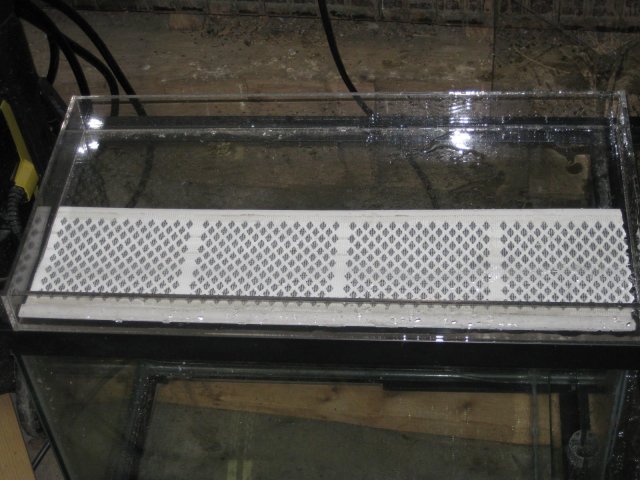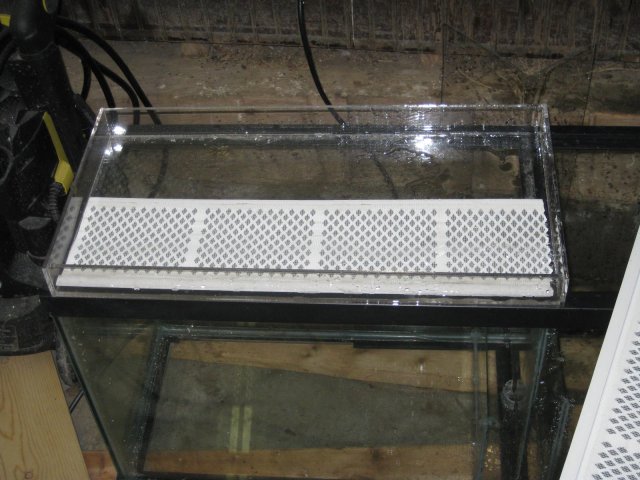What is a boundary layer, and why is it important? It the layer of water that is microscopically close to the algae; the water molecules that actually touch the algae:

This boundary layer area of the water has zero flow, because it has to have the same flow as the algae, which of course is zero. Since there is no flow (velocity) here, nutrient transport through it is slow. The faster the water flow, the smaller the boundary layer, and the faster the nutrients can get to/from the algae from the water.
One point to clarify about nutrient exchange: Contact with air is not needed. Scrubbers operate the same whether they are sealed or open (except for cooling/evap), because the exchange is not with the air; it's with the water. The reason algae grows better in an overflow, or where water hits a scrubber screen, or where waves hit the beach, is because the flow is higher here and thus the water's boundary layer is thinner, which allows for better nutrient transfer between the algae and the water. This is what a vertical waterfall scrubber tries to achieve: Fast flow from top to bottom. Further info can be found here:
Seagrasses: Biology, Ecology, and Conservation, p 199, by AWD Larkum, Robert Joseph Orth, Carlos M. Duarte:
"As water flows through seagrass [or algae] beds, a boundary layer develops on the sediment surface, as well as on each seagrass [and algae] component exposed to the moving water. The faster the water moves, the thinner the diffusive boundary layer (DBL) becomes, and consequently, the faster the transfer of molecules from the water column to the sediment and/or seagrass [or algae]. It follows then that when currents [flow] are weak, the flux of molecules to the seagrass [or algae] surface may be limited by diffusion through the [boundary layer] (i.e., physical limitation). Under those conditions, many biological sites or enzymes in the seagrass [or algae] tissue are available to assimilate molecules when/if [!] they reach the plant's [or algal] surface.

This boundary layer area of the water has zero flow, because it has to have the same flow as the algae, which of course is zero. Since there is no flow (velocity) here, nutrient transport through it is slow. The faster the water flow, the smaller the boundary layer, and the faster the nutrients can get to/from the algae from the water.
One point to clarify about nutrient exchange: Contact with air is not needed. Scrubbers operate the same whether they are sealed or open (except for cooling/evap), because the exchange is not with the air; it's with the water. The reason algae grows better in an overflow, or where water hits a scrubber screen, or where waves hit the beach, is because the flow is higher here and thus the water's boundary layer is thinner, which allows for better nutrient transfer between the algae and the water. This is what a vertical waterfall scrubber tries to achieve: Fast flow from top to bottom. Further info can be found here:
Seagrasses: Biology, Ecology, and Conservation, p 199, by AWD Larkum, Robert Joseph Orth, Carlos M. Duarte:
"As water flows through seagrass [or algae] beds, a boundary layer develops on the sediment surface, as well as on each seagrass [and algae] component exposed to the moving water. The faster the water moves, the thinner the diffusive boundary layer (DBL) becomes, and consequently, the faster the transfer of molecules from the water column to the sediment and/or seagrass [or algae]. It follows then that when currents [flow] are weak, the flux of molecules to the seagrass [or algae] surface may be limited by diffusion through the [boundary layer] (i.e., physical limitation). Under those conditions, many biological sites or enzymes in the seagrass [or algae] tissue are available to assimilate molecules when/if [!] they reach the plant's [or algal] surface.


















